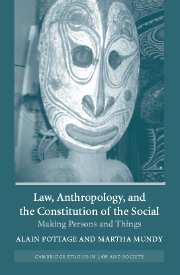Book contents
- Frontmatter
- Contents
- Notes on contributors
- 1 Introduction: the fabrication of persons and things
- 2 Res Religiosae: on the categories of religion and commerce in Roman law
- 3 Scientific objects and legal objectivity
- 4 Legal fabrications and the case of ‘cultural property’
- 5 Ownership or office? A debate in Islamic Hanafite jurisprudence over the nature of the military ‘fief’, from the Mamluks to the Ottomans
- 6 Gedik: a bundle of rights and obligations for Istanbul artisans and traders, 1750–1840
- 7 Losing (out on) intellectual resources
- 8 Re-visualising attachment: an anthropological perspective on persons and property forms
- 9 Our original inheritance
- Bibliography
- Index
8 - Re-visualising attachment: an anthropological perspective on persons and property forms
Published online by Cambridge University Press: 12 July 2009
- Frontmatter
- Contents
- Notes on contributors
- 1 Introduction: the fabrication of persons and things
- 2 Res Religiosae: on the categories of religion and commerce in Roman law
- 3 Scientific objects and legal objectivity
- 4 Legal fabrications and the case of ‘cultural property’
- 5 Ownership or office? A debate in Islamic Hanafite jurisprudence over the nature of the military ‘fief’, from the Mamluks to the Ottomans
- 6 Gedik: a bundle of rights and obligations for Istanbul artisans and traders, 1750–1840
- 7 Losing (out on) intellectual resources
- 8 Re-visualising attachment: an anthropological perspective on persons and property forms
- 9 Our original inheritance
- Bibliography
- Index
Summary
Anthropology and law share certain understandings, the roots of which can be traced to early nineteenth century romantic philosophy. This shared heritage is especially apparent in the entrenched debate over the copyrighting of cultural property, as new nations strive to formulate laws that would protect culture as a form of property. The legal notion of property, based on a model that separates ideas from cultural products and seeks to protect creative agency, is now experienced as being in conflict with radically different expectations of how attachments are formed and thus also best protected – expectations that are grounded in a notion of agency that is attributed not to Man, but to things.
Intellectual property law has been strongly criticised for restricting the fluid and infinitely replicable quality of information judged to be vital to intellectual economies. Political demands for the free flow of information are complemented by theoretical developments in anthropology which emphasise post-modern realities such as globalisation, transnational flows, and creolisation in the invention of tradition. It has been strongly argued that culture can no longer be perceived as a bounded, static entity, but only as a dynamic, constantly re-negotiated process.
How best to protect culture from being copyrighted in the face of this flow of cultural imagery will remain an issue for as long as we adhere to an assumption that has vitally influenced the way we handle the carriers of this imagery.
- Type
- Chapter
- Information
- Law, Anthropology, and the Constitution of the SocialMaking Persons and Things, pp. 234 - 248Publisher: Cambridge University PressPrint publication year: 2004
- 11
- Cited by



